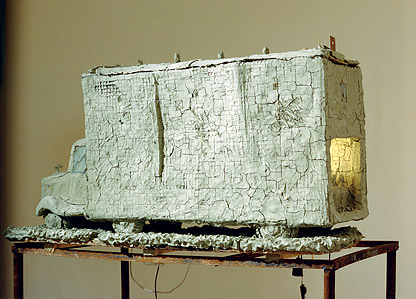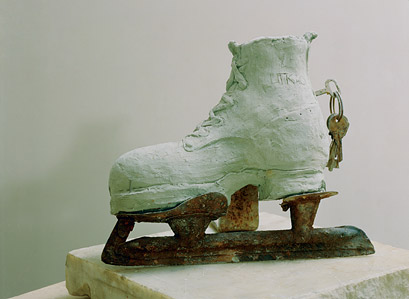 |
Alexander Brodsky
Alexander Brodsky creates impressive metaphors of contemporary reality which always have the air of the eternal and of otherworldly melancholy. His Pet Corner - a model of the unique life of human animals in urban cages - represented Russia at the architectural biennale in Venice. His Coma (in which oil slowly fills up a city) was said by Boris Orlov, a living Sots-Art master, to be the best work of the 1990s. Back then, it seemed to be a harbinger of doom; today, one remembers it as a prophecy coming true. Brodsky's visual language affirms the sublime, growing out of the ashes. Many of his works are realized in destruction, and in touching the order of loss, they manage to convey to us unchanging truth about ourselves.
Alexander Evangely
|
 |
Alexander Brodsky was born to the family of artist Savva Brodsky in 1955 in Starosadsky lane in Moscow.
Studied in Moscow Arts Colledge in 1968-69.
Entered Moscow Architectural Institute in 1972.
Between 1978-1993 worked together with Ilya Utkin on numerous interiors, projects and installations for international competitions and exhibitions.
Between 1993-2000 he was doing graphics, sculpture and installations. His works are held in many museums and private collections.
In 2000 founded his own architectural practice bureau "Alexander Brodsky", which he runs to present date.
Lives and works in Moscow.
|
|

Alexander Brodsky. The Penultimate Day of Pompeii
Part of the installation Turnoff Points. 1997
Unfired clay, video projection, 170x60x80 cm
|
|

Alexander Brodsky. Psychedelic Wagon
1997
Unfired clay, video projection, 100x60x40 cm
|
|

Alexander Brodsky. Gorky Park [The Central Park for Culture and Recreation]
1997
Unfired clay, metal, 35x20 cm
|
|
|
|
Alexander Evangely: What is povera art?
Alexander Brodsky: For me, it's that which is easy to make without having sponsors or special means.
À.Å.: Are budget and art strongly connected?
À.B.: A huge portion of art today is made in accordance to the budget. One can invent whatever one wants, but not everyone has the money for the materialization. I can come up with insane things, but they could never be realized. Whether this is good or bad, it's not clear. A large number of things - good and unequivocally strong - are made at the expense of enormous sponsor investments. While other things are made independently of everything, through easily available means, and the point is that the one is equal to the other. One can go dig up some clay from under his fence or one can do… well, it's clear what. In all probability, if I had the opportunity, I would, out of simple curiosity, make a work with a monstrous budget. But I very happily, with an easy heart, make things which require minimal expenses.
One can develop an aesthetic of "poor" art without being a poor man, one can create deliberately "poor" work - it can be connected, for example, with fashion. If I'm rich, then I can cover a skull with diamonds, or I can, even having the opportunity to do the latter, make something out of dust. It seems to me that one ought to distinguish between such things. Some things are done out of necessity, because only they are possible; and some things are done because the maker specifically likes to create "poor" things, to work in a povera way. Where I am, it's hard for me to tell; probably somewhere in an intermediate phase. I can permit myself big-budget works among others, and my head is full of all sorts of different ideas, this and that. But at the same time, I can permit myself something mid-range.
Besides, if one is not thinking about a budget, I simply love clay very much, unfired clay as a material - universal, beautiful, and pleasant to handle.
|
 |
À.Å.: Does some kind of visual language flow out of this materiality?
À.B.: If one is talking about clay, then yes. It's an amazing thing - in essence, ashes, dust. Not to aim to create something long-lasting out of it, not to fire it, but to turn it into something easily changeable. I have worked a good deal with unfired clay. It is a fragile thing, which easily turns back into ashes and dust, and it can be reused many times - one can grind it, add water, and make an infinite number of new works out of it.
À.Å.: In Russian, there is a meaning of "poor" as something that asks to be pitied.
À.B.: How can one pity art?
À.Å.: Well, the thing is decaying...
À.B.: I have never felt the urge to pity art because it can be deserving only of praise, it is impossible to pity it.
À.Å.: Are the roots of the visual feel of your works architectural ones?
À.B.: Probably, it's hard for me judge. They are not alien to a certain architectural quality. In one form or another, architecture is always present, more or less emphatically. I am an architect, and of course that appears through the works.
À.Å.: There are other juices flowing through them - a sense of history, some sort of repository of life. To what degree does the "poor" correspond to the national well-being?
À.B.: I don't know, I can only evaluate my own. I made "poor" architecture in large quantities. Not everything is all that "poor," but the majority of what I did as an architect were low-budget things out of cheap materials; this too is close to me. This probably is something that sits deep within.
|
|
SELECTED SOLO EXHIBITIONS
2006 Localita Abitata. Installation in the russian pavilion at the Architectural Biennale Venice
2000 Coma. Marat Guelman gallery, Moscow
1996 Canal street subway project. New York, USA
1995 Utopian canalisation. Regina gallery, Moscow
1993 Brodsky & Utkin. Portland Art Museum, USA
1991 Brodsky & Utkin: Etchings. The Lab, San Francisco, USA
1989 Alexander Brodsky and Ilya Utkin. University art gallery, San-Diego State University, USA
|
 |
SELECTED GROUP EXHIBITIONS
2008 Russian povera. Project by Sergey Gordeev. Curator - Marat Guelman. Rechnoi Vokzal,Perm
2006 RUSSIA! Guggenheim Bilbao
2002 25th Biennial de Sao Paulo. Sao Paulo, Brasil
2002 Utopie Guotidiane. Padiglione d'arte contemporaneo, Milano, Italy
2001 Milano Europa 2000. Palazzo della Triennale, Milano, Italy
|
 |
|
 |